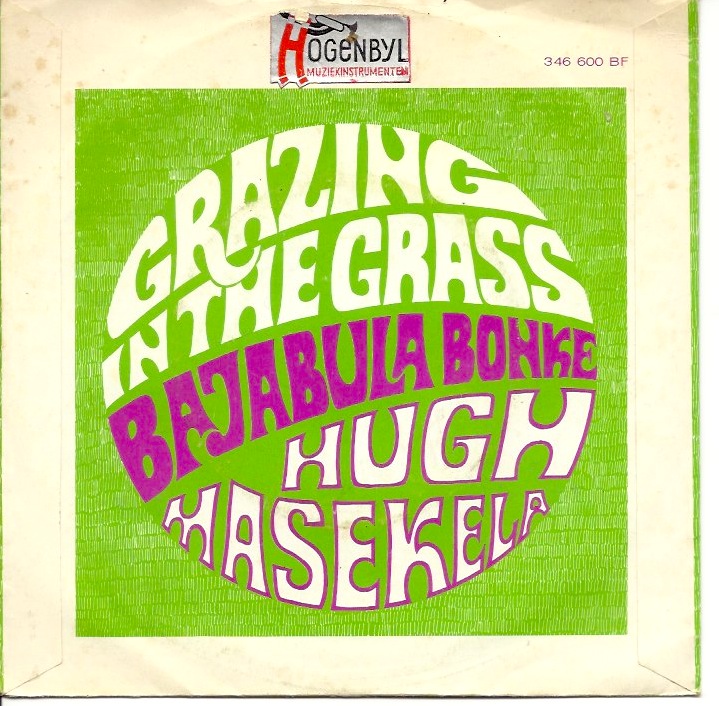July 20, 1968
- STAYED AT #1:2 Weeks
In The Number Ones, I'm reviewing every single #1 single in the history of the Billboard Hot 100, starting with the chart's beginning, in 1958, and working my way up into the present.
How did this happen? How did a South African jazz trumpeter get an instrumental song all the way up to #1 on the US charts? What was going on in the '60s that made something like this possible?
There are factors. Jazz had not quite faded from popular culture in the late '60s. It wasn't pop music, but it was still an artistic and commercial force. Instrumental easy-listening music was still booming; consider, for instance, the dominance of Herb Alpert, who Hugh Masekela dethroned at the #1 spot and with whom Masekela would later record. "Grazing In The Grass," Masekela's one big hit, wasn't easy listening, but it could've been played in some of the same places. "Grazing In The Grass" wasn't a novelty song, either, but maybe that's how it was received at the time, and novelty songs could do huge business back then.
But none of that really explains how "Grazing In The Grass" hit the way it did. Really, the best answer is that there is no answer. The Hot 100 has always been a mysterious beast, but 50 years ago, things were just more anarchic than they are now. It was possible to preconceive and engineer a huge hit back then, but looking at this column, it feels more like a series of happy accidents than a history of immaculately planned crowdpleasers. And if "Grazing In The Grass" was an accident, it was definitely a happy one.
Hugh Masekela grew up in apartheid-era South Africa and was raised by his mother, who ran an illegal speakeasy. He got his first trumpet as a gift from Father Trevor Huddleston, the anti-apartheid activist who worked as a chaplain at his school. In the '50s, Masekela started Johannesburg's first youth jazz orchestra, and Louis Armstrong sent him a trumpet when he heard about Masekela's efforts.
After the 1960 Sharpeville massacre, where South African police opened fire into a crowd of demonstrators and killed 69 of them, Masekela left South Africa. He studied trumpet in London and New York, and briefly was married to Miriam Makeba, the South African singer. In 1967, he played on the Byrds' "So You Wanna Be A Rock 'N' Roll Star" and performed at the Monterey Pop Festival.
In 1968, Masekela recorded The Promise Of A Future, a lush and layered and generally very good album of African-inflected jazz. But when Masekela thought he'd finished the album, producer Stewart Levine, a former classmate of Masekela at the Manhattan School Of Music, pointed out that he was contractually obligated to make a half-hour album and he was three minutes short. So Levine suggested that Masekela cover "Mr. Bull No. 5," a cowbell-heavy record that Maskela had picked up in Zambia. Masekela either covered "Mr. Bull No. 5" or he wrote his own song that was inspired by that one. (I've seen differing accounts online, and "Mr. Bull No. 5" does not appear to be on the internet, so I can't say for sure.)
"Grazing In The Grass" is by no means Masekela's finest work. It's a sprightly, energetic tune that's dominated by its big central horn riff. There is a lot of cowbell, probably too much. Folk guitarist Bruce Langhorne, the man who inspired Bob Dylan's "Mr. Tambourine Man," plays some cool little pinging sounds on guitar. None of it makes a deep impression, but it's a pleasant enough way to spend three minutes. And in retrospect, it's a miracle that a song like this got the chance to do what it did.
Masekela never got anywhere near #1 again, but he still had a hell of a career. He wrote the anti-apartheid anthems "Soweto Blues" and "Bring Him Back Home." He and his producer buddy Stewart Levine organized the Zaire 74 festival, the Kinshasa concert that was supposed to take place right before Muhammad Ali and George Foreman's Rumble In The Jungle match. (There's a ton of footage of that show in the documentaries When We Were Kings and Soul Power, and all of it is incredible.) During that great '80s Graceland/Rhythm Of The Saints era, Masekela toured and recorded with Paul Simon. Masekela was 78 when he died of prostate cancer earlier this year. He lived a life, and that #1 hit was just one weird little chapter of it.
GRADE: 6/10
BONUS BEATS: In 1969, the Friends Of Distinction, a vocal group from Los Angeles who were discovered by the football star Jim Brown, hit #3 with a lyrics-added version of "Grazing In The Grass." (That would've also been a 6.) Here's their version:
And here's the inside-joke scene from the 1988 movie I'm Gonna Git You Sucka where Isaac Hayes purposefully annoys Jim Brown by singing along badly with the Friends Of Distinction version of "Grazing In The Grass":
BONUS BONUS BEATS: Here's Sugar Ray's video for their 1999 single "Every Morning," which sampled "Grazing In The Grass":
"Every Morning," which peaked at #3, was Sugar Ray's highest-charting single. It would've been a 5.






